Leading Employees Toward Unemployment: Unit Report, 2019
VerifiedAdded on 2022/11/29
|20
|5705
|64
Report
AI Summary
This report analyzes the challenges faced by Petrokemija d.o.o., a Croatian company undergoing privatization, and its impact on employee motivation and potential unemployment. The paper explores complex adaptive leadership, information sharing, leadership development, and change resistance within the context of the company's transformation. It examines the perverse situation where good performance may lead to layoffs, the limitations of self-management, and the need for complex adaptive leadership. The report reviews relevant literature, including works by Obolensky, Heath and Heath, Dimitriadis and Psychogios, and others, and applies these concepts to the company's situation. The report concludes with recommendations for improving leadership practices and employee engagement to mitigate the negative impacts of organizational change. The student has contributed this report to Desklib, a platform providing AI-powered study tools.
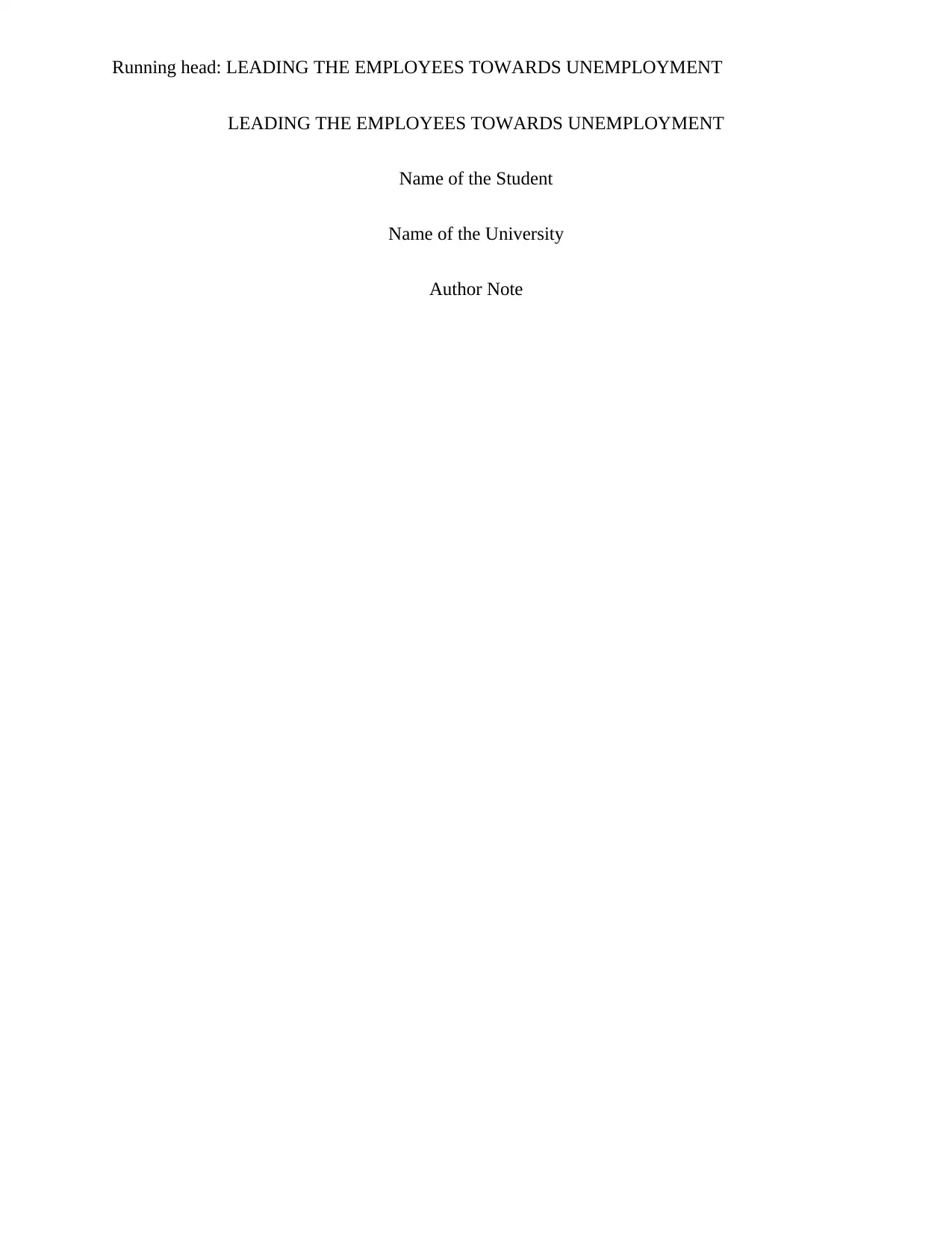
Running head: LEADING THE EMPLOYEES TOWARDS UNEMPLOYMENT
LEADING THE EMPLOYEES TOWARDS UNEMPLOYMENT
Name of the Student
Name of the University
Author Note
LEADING THE EMPLOYEES TOWARDS UNEMPLOYMENT
Name of the Student
Name of the University
Author Note
Paraphrase This Document
Need a fresh take? Get an instant paraphrase of this document with our AI Paraphraser
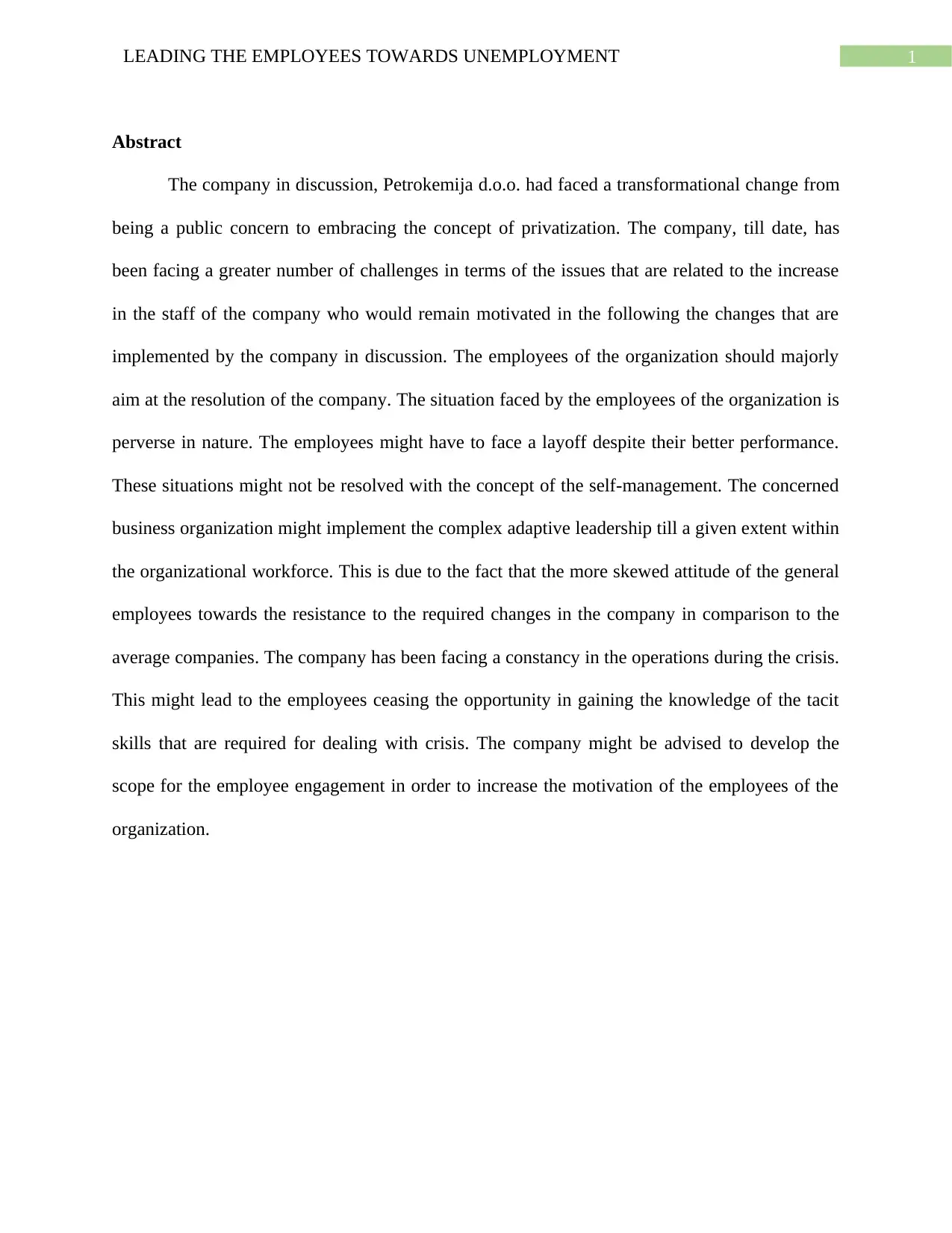
1LEADING THE EMPLOYEES TOWARDS UNEMPLOYMENT
Abstract
The company in discussion, Petrokemija d.o.o. had faced a transformational change from
being a public concern to embracing the concept of privatization. The company, till date, has
been facing a greater number of challenges in terms of the issues that are related to the increase
in the staff of the company who would remain motivated in the following the changes that are
implemented by the company in discussion. The employees of the organization should majorly
aim at the resolution of the company. The situation faced by the employees of the organization is
perverse in nature. The employees might have to face a layoff despite their better performance.
These situations might not be resolved with the concept of the self-management. The concerned
business organization might implement the complex adaptive leadership till a given extent within
the organizational workforce. This is due to the fact that the more skewed attitude of the general
employees towards the resistance to the required changes in the company in comparison to the
average companies. The company has been facing a constancy in the operations during the crisis.
This might lead to the employees ceasing the opportunity in gaining the knowledge of the tacit
skills that are required for dealing with crisis. The company might be advised to develop the
scope for the employee engagement in order to increase the motivation of the employees of the
organization.
Abstract
The company in discussion, Petrokemija d.o.o. had faced a transformational change from
being a public concern to embracing the concept of privatization. The company, till date, has
been facing a greater number of challenges in terms of the issues that are related to the increase
in the staff of the company who would remain motivated in the following the changes that are
implemented by the company in discussion. The employees of the organization should majorly
aim at the resolution of the company. The situation faced by the employees of the organization is
perverse in nature. The employees might have to face a layoff despite their better performance.
These situations might not be resolved with the concept of the self-management. The concerned
business organization might implement the complex adaptive leadership till a given extent within
the organizational workforce. This is due to the fact that the more skewed attitude of the general
employees towards the resistance to the required changes in the company in comparison to the
average companies. The company has been facing a constancy in the operations during the crisis.
This might lead to the employees ceasing the opportunity in gaining the knowledge of the tacit
skills that are required for dealing with crisis. The company might be advised to develop the
scope for the employee engagement in order to increase the motivation of the employees of the
organization.
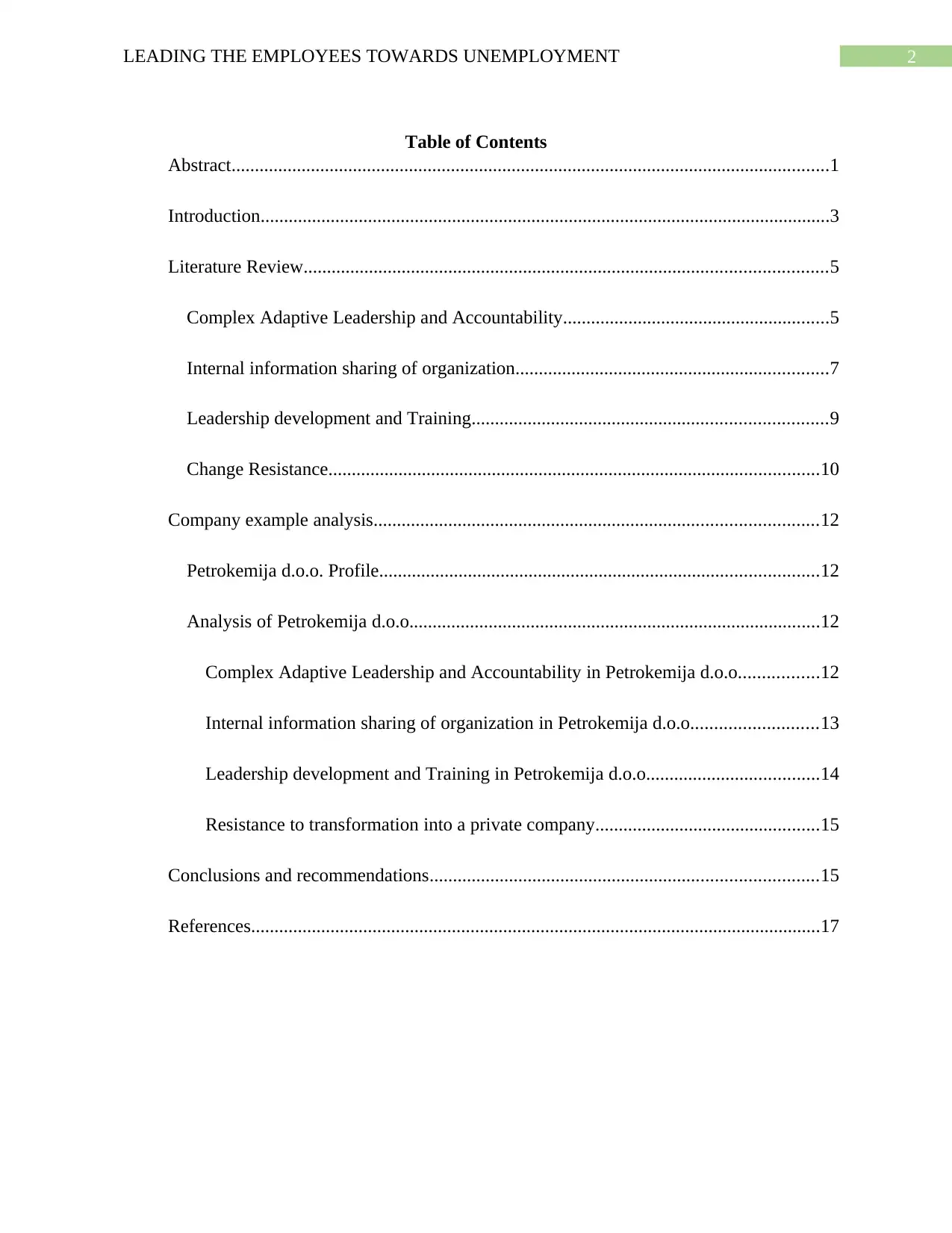
2LEADING THE EMPLOYEES TOWARDS UNEMPLOYMENT
Table of Contents
Abstract................................................................................................................................1
Introduction..........................................................................................................................3
Literature Review................................................................................................................5
Complex Adaptive Leadership and Accountability.........................................................5
Internal information sharing of organization...................................................................7
Leadership development and Training............................................................................9
Change Resistance.........................................................................................................10
Company example analysis...............................................................................................12
Petrokemija d.o.o. Profile..............................................................................................12
Analysis of Petrokemija d.o.o........................................................................................12
Complex Adaptive Leadership and Accountability in Petrokemija d.o.o.................12
Internal information sharing of organization in Petrokemija d.o.o...........................13
Leadership development and Training in Petrokemija d.o.o.....................................14
Resistance to transformation into a private company................................................15
Conclusions and recommendations...................................................................................15
References..........................................................................................................................17
Table of Contents
Abstract................................................................................................................................1
Introduction..........................................................................................................................3
Literature Review................................................................................................................5
Complex Adaptive Leadership and Accountability.........................................................5
Internal information sharing of organization...................................................................7
Leadership development and Training............................................................................9
Change Resistance.........................................................................................................10
Company example analysis...............................................................................................12
Petrokemija d.o.o. Profile..............................................................................................12
Analysis of Petrokemija d.o.o........................................................................................12
Complex Adaptive Leadership and Accountability in Petrokemija d.o.o.................12
Internal information sharing of organization in Petrokemija d.o.o...........................13
Leadership development and Training in Petrokemija d.o.o.....................................14
Resistance to transformation into a private company................................................15
Conclusions and recommendations...................................................................................15
References..........................................................................................................................17
⊘ This is a preview!⊘
Do you want full access?
Subscribe today to unlock all pages.

Trusted by 1+ million students worldwide
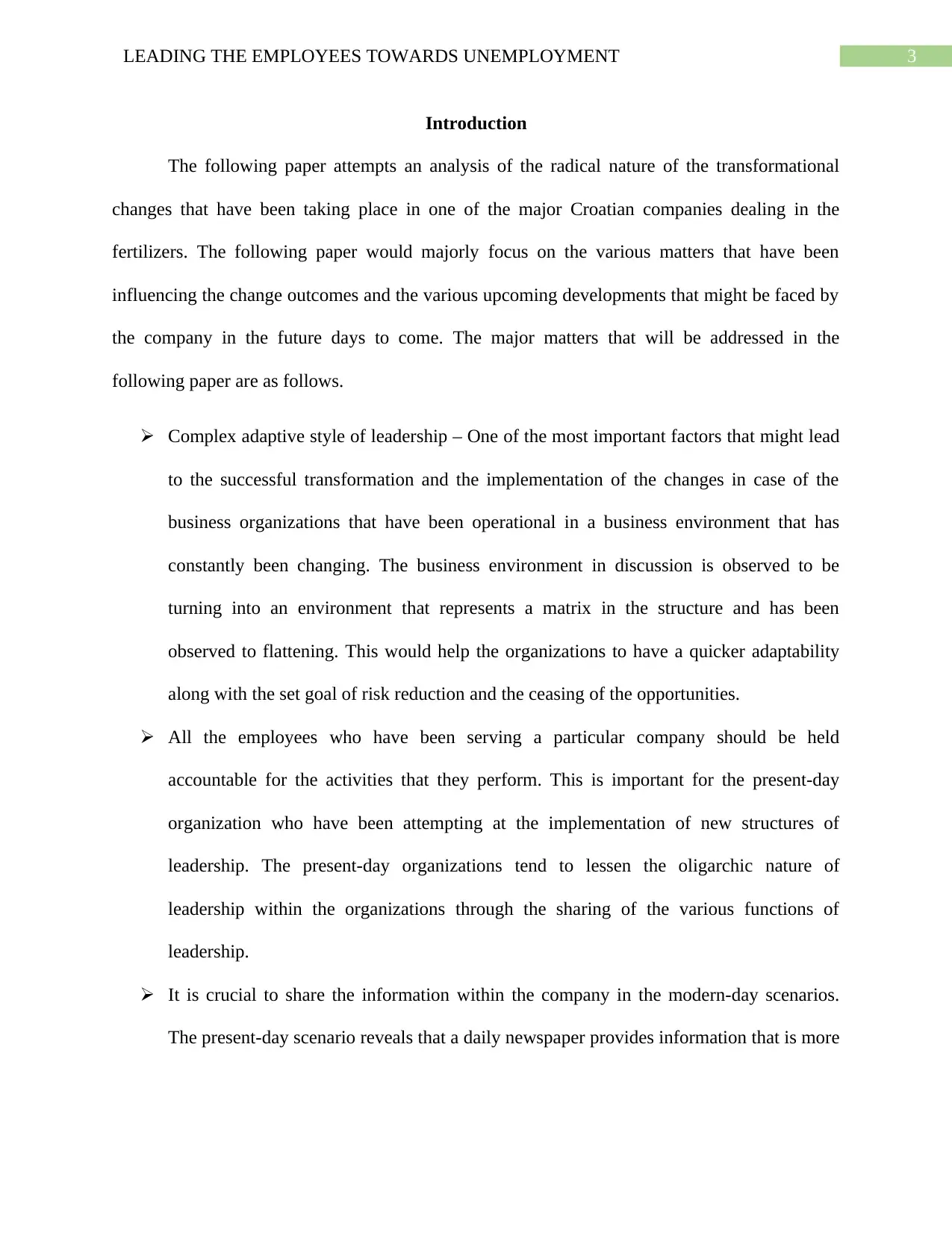
3LEADING THE EMPLOYEES TOWARDS UNEMPLOYMENT
Introduction
The following paper attempts an analysis of the radical nature of the transformational
changes that have been taking place in one of the major Croatian companies dealing in the
fertilizers. The following paper would majorly focus on the various matters that have been
influencing the change outcomes and the various upcoming developments that might be faced by
the company in the future days to come. The major matters that will be addressed in the
following paper are as follows.
Complex adaptive style of leadership – One of the most important factors that might lead
to the successful transformation and the implementation of the changes in case of the
business organizations that have been operational in a business environment that has
constantly been changing. The business environment in discussion is observed to be
turning into an environment that represents a matrix in the structure and has been
observed to flattening. This would help the organizations to have a quicker adaptability
along with the set goal of risk reduction and the ceasing of the opportunities.
All the employees who have been serving a particular company should be held
accountable for the activities that they perform. This is important for the present-day
organization who have been attempting at the implementation of new structures of
leadership. The present-day organizations tend to lessen the oligarchic nature of
leadership within the organizations through the sharing of the various functions of
leadership.
It is crucial to share the information within the company in the modern-day scenarios.
The present-day scenario reveals that a daily newspaper provides information that is more
Introduction
The following paper attempts an analysis of the radical nature of the transformational
changes that have been taking place in one of the major Croatian companies dealing in the
fertilizers. The following paper would majorly focus on the various matters that have been
influencing the change outcomes and the various upcoming developments that might be faced by
the company in the future days to come. The major matters that will be addressed in the
following paper are as follows.
Complex adaptive style of leadership – One of the most important factors that might lead
to the successful transformation and the implementation of the changes in case of the
business organizations that have been operational in a business environment that has
constantly been changing. The business environment in discussion is observed to be
turning into an environment that represents a matrix in the structure and has been
observed to flattening. This would help the organizations to have a quicker adaptability
along with the set goal of risk reduction and the ceasing of the opportunities.
All the employees who have been serving a particular company should be held
accountable for the activities that they perform. This is important for the present-day
organization who have been attempting at the implementation of new structures of
leadership. The present-day organizations tend to lessen the oligarchic nature of
leadership within the organizations through the sharing of the various functions of
leadership.
It is crucial to share the information within the company in the modern-day scenarios.
The present-day scenario reveals that a daily newspaper provides information that is more
Paraphrase This Document
Need a fresh take? Get an instant paraphrase of this document with our AI Paraphraser
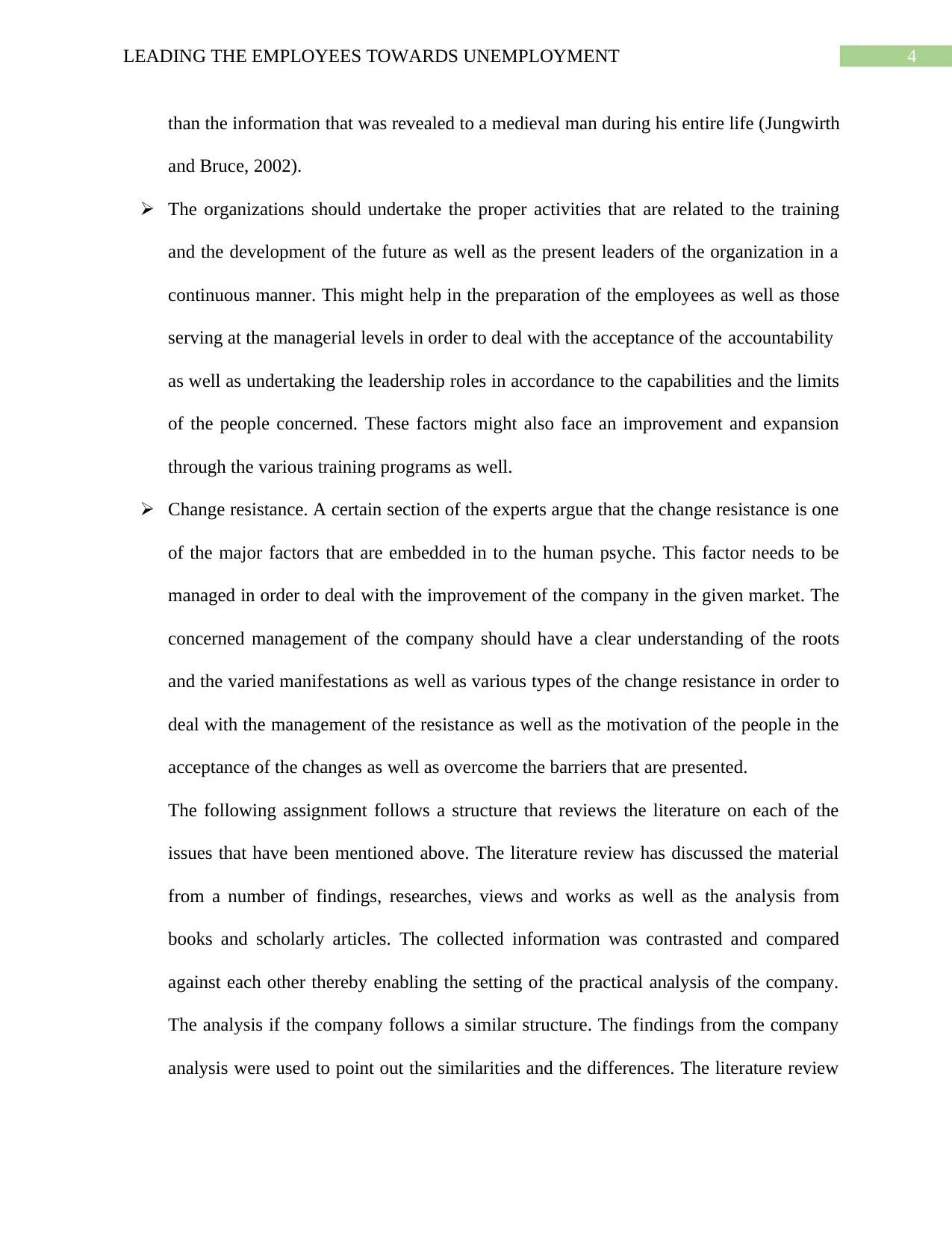
4LEADING THE EMPLOYEES TOWARDS UNEMPLOYMENT
than the information that was revealed to a medieval man during his entire life (Jungwirth
and Bruce, 2002).
The organizations should undertake the proper activities that are related to the training
and the development of the future as well as the present leaders of the organization in a
continuous manner. This might help in the preparation of the employees as well as those
serving at the managerial levels in order to deal with the acceptance of the accountability
as well as undertaking the leadership roles in accordance to the capabilities and the limits
of the people concerned. These factors might also face an improvement and expansion
through the various training programs as well.
Change resistance. A certain section of the experts argue that the change resistance is one
of the major factors that are embedded in to the human psyche. This factor needs to be
managed in order to deal with the improvement of the company in the given market. The
concerned management of the company should have a clear understanding of the roots
and the varied manifestations as well as various types of the change resistance in order to
deal with the management of the resistance as well as the motivation of the people in the
acceptance of the changes as well as overcome the barriers that are presented.
The following assignment follows a structure that reviews the literature on each of the
issues that have been mentioned above. The literature review has discussed the material
from a number of findings, researches, views and works as well as the analysis from
books and scholarly articles. The collected information was contrasted and compared
against each other thereby enabling the setting of the practical analysis of the company.
The analysis if the company follows a similar structure. The findings from the company
analysis were used to point out the similarities and the differences. The literature review
than the information that was revealed to a medieval man during his entire life (Jungwirth
and Bruce, 2002).
The organizations should undertake the proper activities that are related to the training
and the development of the future as well as the present leaders of the organization in a
continuous manner. This might help in the preparation of the employees as well as those
serving at the managerial levels in order to deal with the acceptance of the accountability
as well as undertaking the leadership roles in accordance to the capabilities and the limits
of the people concerned. These factors might also face an improvement and expansion
through the various training programs as well.
Change resistance. A certain section of the experts argue that the change resistance is one
of the major factors that are embedded in to the human psyche. This factor needs to be
managed in order to deal with the improvement of the company in the given market. The
concerned management of the company should have a clear understanding of the roots
and the varied manifestations as well as various types of the change resistance in order to
deal with the management of the resistance as well as the motivation of the people in the
acceptance of the changes as well as overcome the barriers that are presented.
The following assignment follows a structure that reviews the literature on each of the
issues that have been mentioned above. The literature review has discussed the material
from a number of findings, researches, views and works as well as the analysis from
books and scholarly articles. The collected information was contrasted and compared
against each other thereby enabling the setting of the practical analysis of the company.
The analysis if the company follows a similar structure. The findings from the company
analysis were used to point out the similarities and the differences. The literature review
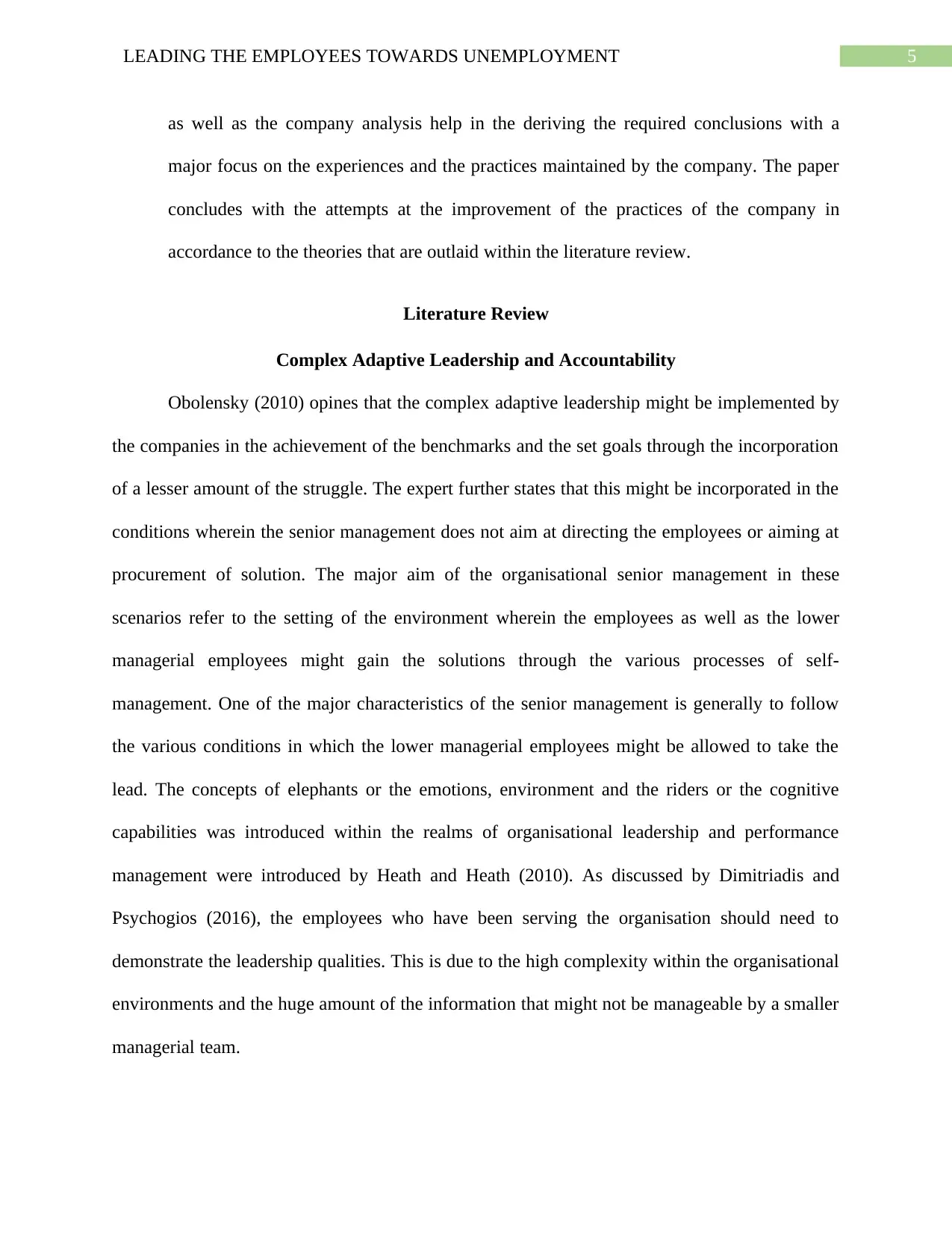
5LEADING THE EMPLOYEES TOWARDS UNEMPLOYMENT
as well as the company analysis help in the deriving the required conclusions with a
major focus on the experiences and the practices maintained by the company. The paper
concludes with the attempts at the improvement of the practices of the company in
accordance to the theories that are outlaid within the literature review.
Literature Review
Complex Adaptive Leadership and Accountability
Obolensky (2010) opines that the complex adaptive leadership might be implemented by
the companies in the achievement of the benchmarks and the set goals through the incorporation
of a lesser amount of the struggle. The expert further states that this might be incorporated in the
conditions wherein the senior management does not aim at directing the employees or aiming at
procurement of solution. The major aim of the organisational senior management in these
scenarios refer to the setting of the environment wherein the employees as well as the lower
managerial employees might gain the solutions through the various processes of self-
management. One of the major characteristics of the senior management is generally to follow
the various conditions in which the lower managerial employees might be allowed to take the
lead. The concepts of elephants or the emotions, environment and the riders or the cognitive
capabilities was introduced within the realms of organisational leadership and performance
management were introduced by Heath and Heath (2010). As discussed by Dimitriadis and
Psychogios (2016), the employees who have been serving the organisation should need to
demonstrate the leadership qualities. This is due to the high complexity within the organisational
environments and the huge amount of the information that might not be manageable by a smaller
managerial team.
as well as the company analysis help in the deriving the required conclusions with a
major focus on the experiences and the practices maintained by the company. The paper
concludes with the attempts at the improvement of the practices of the company in
accordance to the theories that are outlaid within the literature review.
Literature Review
Complex Adaptive Leadership and Accountability
Obolensky (2010) opines that the complex adaptive leadership might be implemented by
the companies in the achievement of the benchmarks and the set goals through the incorporation
of a lesser amount of the struggle. The expert further states that this might be incorporated in the
conditions wherein the senior management does not aim at directing the employees or aiming at
procurement of solution. The major aim of the organisational senior management in these
scenarios refer to the setting of the environment wherein the employees as well as the lower
managerial employees might gain the solutions through the various processes of self-
management. One of the major characteristics of the senior management is generally to follow
the various conditions in which the lower managerial employees might be allowed to take the
lead. The concepts of elephants or the emotions, environment and the riders or the cognitive
capabilities was introduced within the realms of organisational leadership and performance
management were introduced by Heath and Heath (2010). As discussed by Dimitriadis and
Psychogios (2016), the employees who have been serving the organisation should need to
demonstrate the leadership qualities. This is due to the high complexity within the organisational
environments and the huge amount of the information that might not be manageable by a smaller
managerial team.
⊘ This is a preview!⊘
Do you want full access?
Subscribe today to unlock all pages.

Trusted by 1+ million students worldwide
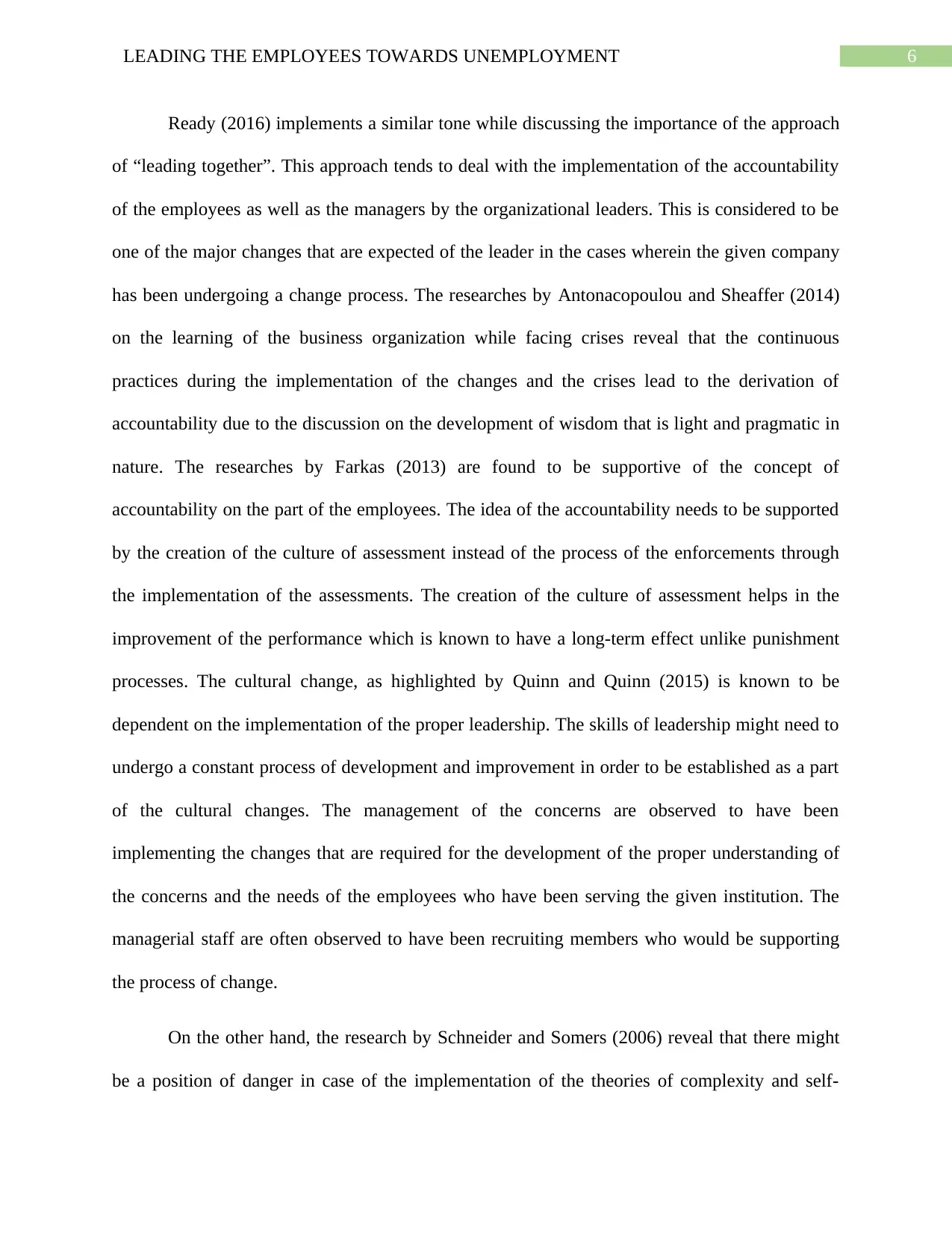
6LEADING THE EMPLOYEES TOWARDS UNEMPLOYMENT
Ready (2016) implements a similar tone while discussing the importance of the approach
of “leading together”. This approach tends to deal with the implementation of the accountability
of the employees as well as the managers by the organizational leaders. This is considered to be
one of the major changes that are expected of the leader in the cases wherein the given company
has been undergoing a change process. The researches by Antonacopoulou and Sheaffer (2014)
on the learning of the business organization while facing crises reveal that the continuous
practices during the implementation of the changes and the crises lead to the derivation of
accountability due to the discussion on the development of wisdom that is light and pragmatic in
nature. The researches by Farkas (2013) are found to be supportive of the concept of
accountability on the part of the employees. The idea of the accountability needs to be supported
by the creation of the culture of assessment instead of the process of the enforcements through
the implementation of the assessments. The creation of the culture of assessment helps in the
improvement of the performance which is known to have a long-term effect unlike punishment
processes. The cultural change, as highlighted by Quinn and Quinn (2015) is known to be
dependent on the implementation of the proper leadership. The skills of leadership might need to
undergo a constant process of development and improvement in order to be established as a part
of the cultural changes. The management of the concerns are observed to have been
implementing the changes that are required for the development of the proper understanding of
the concerns and the needs of the employees who have been serving the given institution. The
managerial staff are often observed to have been recruiting members who would be supporting
the process of change.
On the other hand, the research by Schneider and Somers (2006) reveal that there might
be a position of danger in case of the implementation of the theories of complexity and self-
Ready (2016) implements a similar tone while discussing the importance of the approach
of “leading together”. This approach tends to deal with the implementation of the accountability
of the employees as well as the managers by the organizational leaders. This is considered to be
one of the major changes that are expected of the leader in the cases wherein the given company
has been undergoing a change process. The researches by Antonacopoulou and Sheaffer (2014)
on the learning of the business organization while facing crises reveal that the continuous
practices during the implementation of the changes and the crises lead to the derivation of
accountability due to the discussion on the development of wisdom that is light and pragmatic in
nature. The researches by Farkas (2013) are found to be supportive of the concept of
accountability on the part of the employees. The idea of the accountability needs to be supported
by the creation of the culture of assessment instead of the process of the enforcements through
the implementation of the assessments. The creation of the culture of assessment helps in the
improvement of the performance which is known to have a long-term effect unlike punishment
processes. The cultural change, as highlighted by Quinn and Quinn (2015) is known to be
dependent on the implementation of the proper leadership. The skills of leadership might need to
undergo a constant process of development and improvement in order to be established as a part
of the cultural changes. The management of the concerns are observed to have been
implementing the changes that are required for the development of the proper understanding of
the concerns and the needs of the employees who have been serving the given institution. The
managerial staff are often observed to have been recruiting members who would be supporting
the process of change.
On the other hand, the research by Schneider and Somers (2006) reveal that there might
be a position of danger in case of the implementation of the theories of complexity and self-
Paraphrase This Document
Need a fresh take? Get an instant paraphrase of this document with our AI Paraphraser
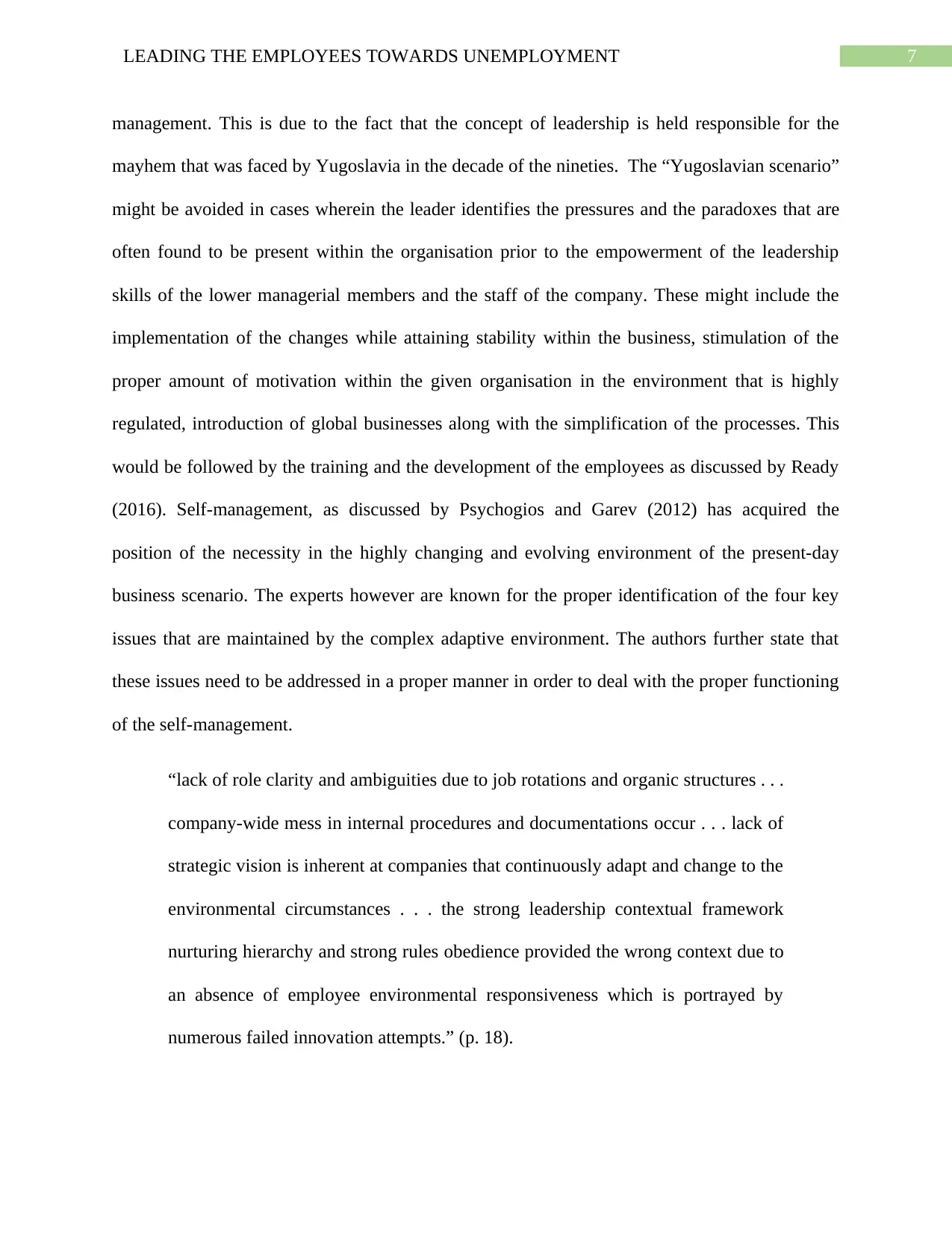
7LEADING THE EMPLOYEES TOWARDS UNEMPLOYMENT
management. This is due to the fact that the concept of leadership is held responsible for the
mayhem that was faced by Yugoslavia in the decade of the nineties. The “Yugoslavian scenario”
might be avoided in cases wherein the leader identifies the pressures and the paradoxes that are
often found to be present within the organisation prior to the empowerment of the leadership
skills of the lower managerial members and the staff of the company. These might include the
implementation of the changes while attaining stability within the business, stimulation of the
proper amount of motivation within the given organisation in the environment that is highly
regulated, introduction of global businesses along with the simplification of the processes. This
would be followed by the training and the development of the employees as discussed by Ready
(2016). Self-management, as discussed by Psychogios and Garev (2012) has acquired the
position of the necessity in the highly changing and evolving environment of the present-day
business scenario. The experts however are known for the proper identification of the four key
issues that are maintained by the complex adaptive environment. The authors further state that
these issues need to be addressed in a proper manner in order to deal with the proper functioning
of the self-management.
“lack of role clarity and ambiguities due to job rotations and organic structures . . .
company-wide mess in internal procedures and documentations occur . . . lack of
strategic vision is inherent at companies that continuously adapt and change to the
environmental circumstances . . . the strong leadership contextual framework
nurturing hierarchy and strong rules obedience provided the wrong context due to
an absence of employee environmental responsiveness which is portrayed by
numerous failed innovation attempts.” (p. 18).
management. This is due to the fact that the concept of leadership is held responsible for the
mayhem that was faced by Yugoslavia in the decade of the nineties. The “Yugoslavian scenario”
might be avoided in cases wherein the leader identifies the pressures and the paradoxes that are
often found to be present within the organisation prior to the empowerment of the leadership
skills of the lower managerial members and the staff of the company. These might include the
implementation of the changes while attaining stability within the business, stimulation of the
proper amount of motivation within the given organisation in the environment that is highly
regulated, introduction of global businesses along with the simplification of the processes. This
would be followed by the training and the development of the employees as discussed by Ready
(2016). Self-management, as discussed by Psychogios and Garev (2012) has acquired the
position of the necessity in the highly changing and evolving environment of the present-day
business scenario. The experts however are known for the proper identification of the four key
issues that are maintained by the complex adaptive environment. The authors further state that
these issues need to be addressed in a proper manner in order to deal with the proper functioning
of the self-management.
“lack of role clarity and ambiguities due to job rotations and organic structures . . .
company-wide mess in internal procedures and documentations occur . . . lack of
strategic vision is inherent at companies that continuously adapt and change to the
environmental circumstances . . . the strong leadership contextual framework
nurturing hierarchy and strong rules obedience provided the wrong context due to
an absence of employee environmental responsiveness which is portrayed by
numerous failed innovation attempts.” (p. 18).
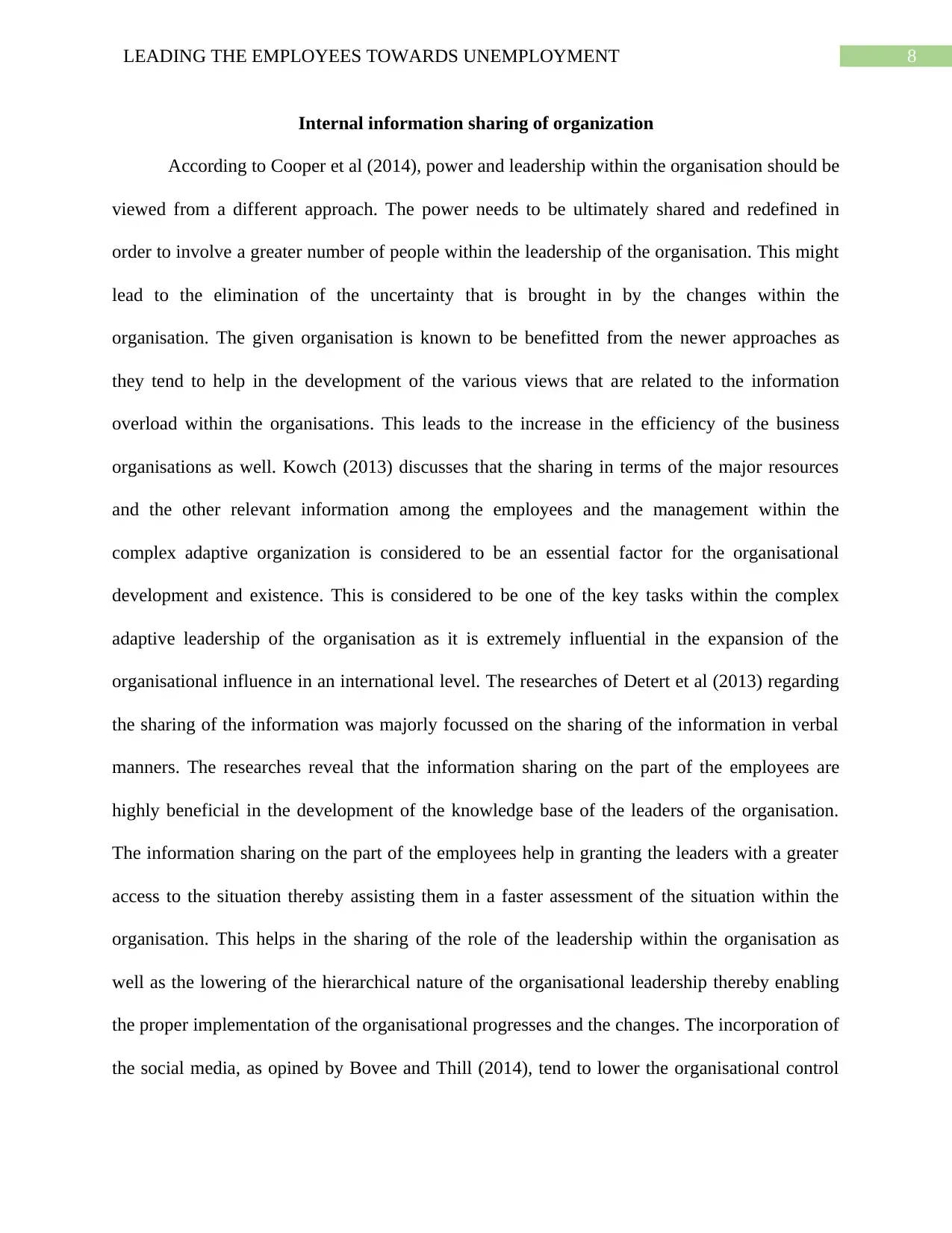
8LEADING THE EMPLOYEES TOWARDS UNEMPLOYMENT
Internal information sharing of organization
According to Cooper et al (2014), power and leadership within the organisation should be
viewed from a different approach. The power needs to be ultimately shared and redefined in
order to involve a greater number of people within the leadership of the organisation. This might
lead to the elimination of the uncertainty that is brought in by the changes within the
organisation. The given organisation is known to be benefitted from the newer approaches as
they tend to help in the development of the various views that are related to the information
overload within the organisations. This leads to the increase in the efficiency of the business
organisations as well. Kowch (2013) discusses that the sharing in terms of the major resources
and the other relevant information among the employees and the management within the
complex adaptive organization is considered to be an essential factor for the organisational
development and existence. This is considered to be one of the key tasks within the complex
adaptive leadership of the organisation as it is extremely influential in the expansion of the
organisational influence in an international level. The researches of Detert et al (2013) regarding
the sharing of the information was majorly focussed on the sharing of the information in verbal
manners. The researches reveal that the information sharing on the part of the employees are
highly beneficial in the development of the knowledge base of the leaders of the organisation.
The information sharing on the part of the employees help in granting the leaders with a greater
access to the situation thereby assisting them in a faster assessment of the situation within the
organisation. This helps in the sharing of the role of the leadership within the organisation as
well as the lowering of the hierarchical nature of the organisational leadership thereby enabling
the proper implementation of the organisational progresses and the changes. The incorporation of
the social media, as opined by Bovee and Thill (2014), tend to lower the organisational control
Internal information sharing of organization
According to Cooper et al (2014), power and leadership within the organisation should be
viewed from a different approach. The power needs to be ultimately shared and redefined in
order to involve a greater number of people within the leadership of the organisation. This might
lead to the elimination of the uncertainty that is brought in by the changes within the
organisation. The given organisation is known to be benefitted from the newer approaches as
they tend to help in the development of the various views that are related to the information
overload within the organisations. This leads to the increase in the efficiency of the business
organisations as well. Kowch (2013) discusses that the sharing in terms of the major resources
and the other relevant information among the employees and the management within the
complex adaptive organization is considered to be an essential factor for the organisational
development and existence. This is considered to be one of the key tasks within the complex
adaptive leadership of the organisation as it is extremely influential in the expansion of the
organisational influence in an international level. The researches of Detert et al (2013) regarding
the sharing of the information was majorly focussed on the sharing of the information in verbal
manners. The researches reveal that the information sharing on the part of the employees are
highly beneficial in the development of the knowledge base of the leaders of the organisation.
The information sharing on the part of the employees help in granting the leaders with a greater
access to the situation thereby assisting them in a faster assessment of the situation within the
organisation. This helps in the sharing of the role of the leadership within the organisation as
well as the lowering of the hierarchical nature of the organisational leadership thereby enabling
the proper implementation of the organisational progresses and the changes. The incorporation of
the social media, as opined by Bovee and Thill (2014), tend to lower the organisational control
⊘ This is a preview!⊘
Do you want full access?
Subscribe today to unlock all pages.

Trusted by 1+ million students worldwide
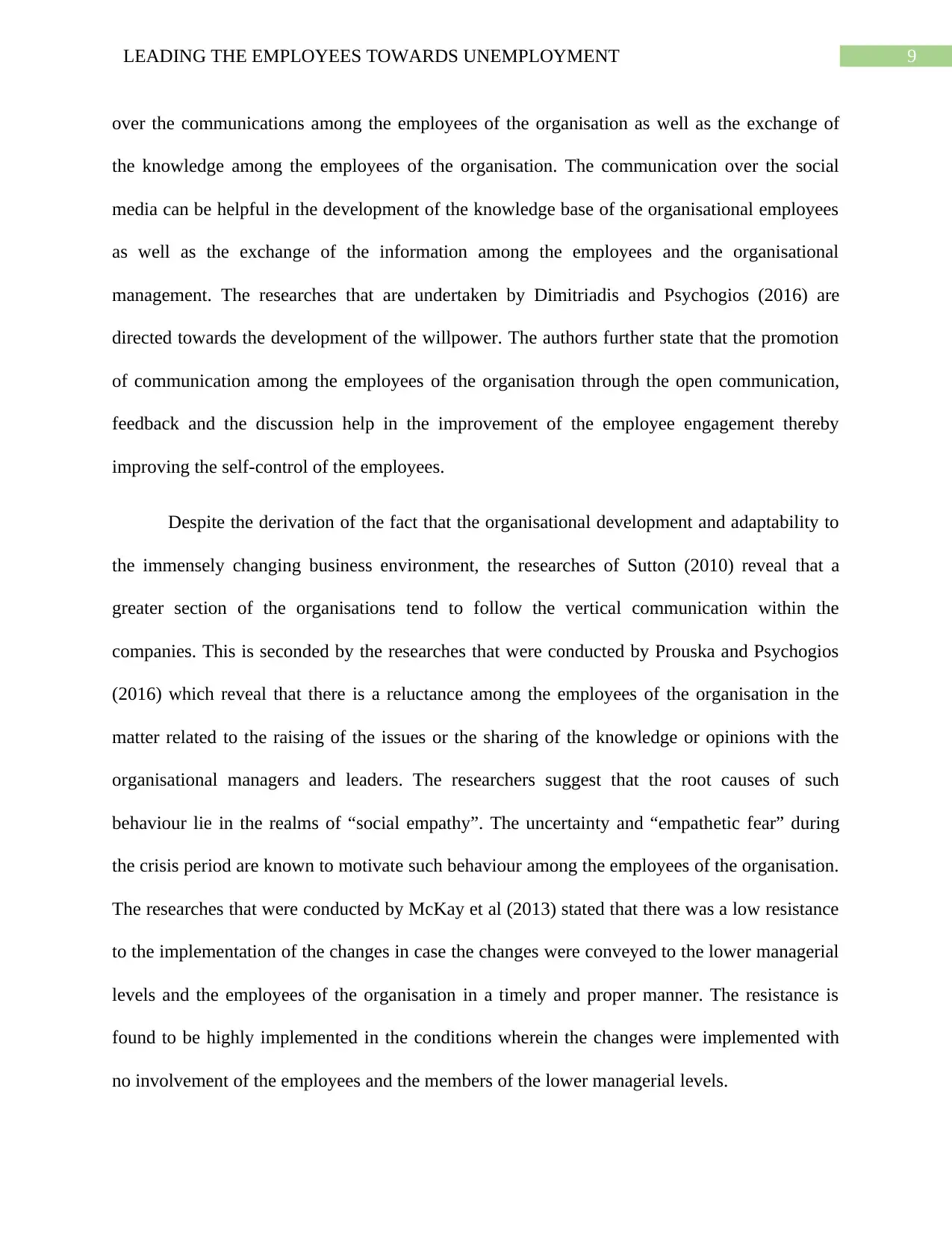
9LEADING THE EMPLOYEES TOWARDS UNEMPLOYMENT
over the communications among the employees of the organisation as well as the exchange of
the knowledge among the employees of the organisation. The communication over the social
media can be helpful in the development of the knowledge base of the organisational employees
as well as the exchange of the information among the employees and the organisational
management. The researches that are undertaken by Dimitriadis and Psychogios (2016) are
directed towards the development of the willpower. The authors further state that the promotion
of communication among the employees of the organisation through the open communication,
feedback and the discussion help in the improvement of the employee engagement thereby
improving the self-control of the employees.
Despite the derivation of the fact that the organisational development and adaptability to
the immensely changing business environment, the researches of Sutton (2010) reveal that a
greater section of the organisations tend to follow the vertical communication within the
companies. This is seconded by the researches that were conducted by Prouska and Psychogios
(2016) which reveal that there is a reluctance among the employees of the organisation in the
matter related to the raising of the issues or the sharing of the knowledge or opinions with the
organisational managers and leaders. The researchers suggest that the root causes of such
behaviour lie in the realms of “social empathy”. The uncertainty and “empathetic fear” during
the crisis period are known to motivate such behaviour among the employees of the organisation.
The researches that were conducted by McKay et al (2013) stated that there was a low resistance
to the implementation of the changes in case the changes were conveyed to the lower managerial
levels and the employees of the organisation in a timely and proper manner. The resistance is
found to be highly implemented in the conditions wherein the changes were implemented with
no involvement of the employees and the members of the lower managerial levels.
over the communications among the employees of the organisation as well as the exchange of
the knowledge among the employees of the organisation. The communication over the social
media can be helpful in the development of the knowledge base of the organisational employees
as well as the exchange of the information among the employees and the organisational
management. The researches that are undertaken by Dimitriadis and Psychogios (2016) are
directed towards the development of the willpower. The authors further state that the promotion
of communication among the employees of the organisation through the open communication,
feedback and the discussion help in the improvement of the employee engagement thereby
improving the self-control of the employees.
Despite the derivation of the fact that the organisational development and adaptability to
the immensely changing business environment, the researches of Sutton (2010) reveal that a
greater section of the organisations tend to follow the vertical communication within the
companies. This is seconded by the researches that were conducted by Prouska and Psychogios
(2016) which reveal that there is a reluctance among the employees of the organisation in the
matter related to the raising of the issues or the sharing of the knowledge or opinions with the
organisational managers and leaders. The researchers suggest that the root causes of such
behaviour lie in the realms of “social empathy”. The uncertainty and “empathetic fear” during
the crisis period are known to motivate such behaviour among the employees of the organisation.
The researches that were conducted by McKay et al (2013) stated that there was a low resistance
to the implementation of the changes in case the changes were conveyed to the lower managerial
levels and the employees of the organisation in a timely and proper manner. The resistance is
found to be highly implemented in the conditions wherein the changes were implemented with
no involvement of the employees and the members of the lower managerial levels.
Paraphrase This Document
Need a fresh take? Get an instant paraphrase of this document with our AI Paraphraser
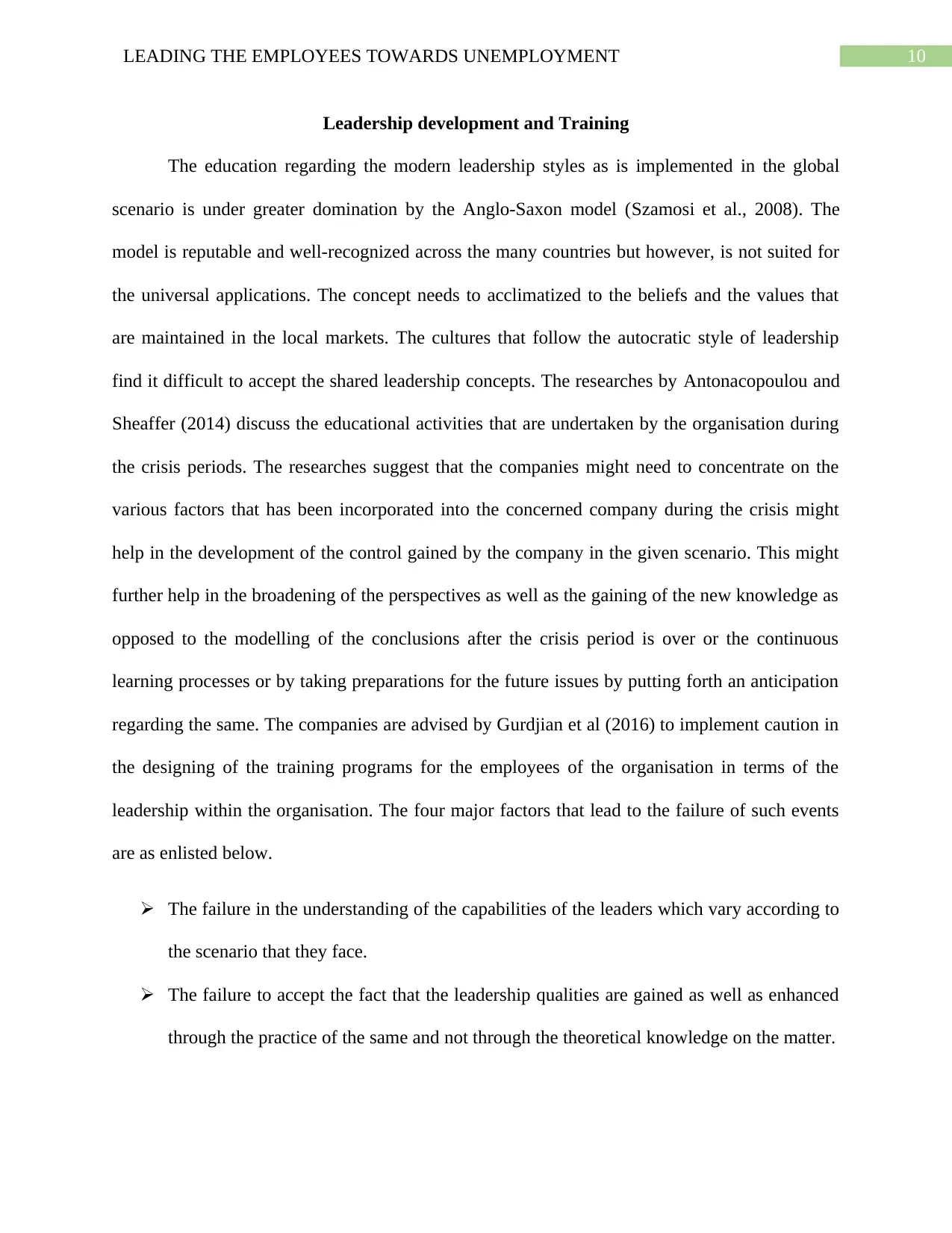
10LEADING THE EMPLOYEES TOWARDS UNEMPLOYMENT
Leadership development and Training
The education regarding the modern leadership styles as is implemented in the global
scenario is under greater domination by the Anglo-Saxon model (Szamosi et al., 2008). The
model is reputable and well-recognized across the many countries but however, is not suited for
the universal applications. The concept needs to acclimatized to the beliefs and the values that
are maintained in the local markets. The cultures that follow the autocratic style of leadership
find it difficult to accept the shared leadership concepts. The researches by Antonacopoulou and
Sheaffer (2014) discuss the educational activities that are undertaken by the organisation during
the crisis periods. The researches suggest that the companies might need to concentrate on the
various factors that has been incorporated into the concerned company during the crisis might
help in the development of the control gained by the company in the given scenario. This might
further help in the broadening of the perspectives as well as the gaining of the new knowledge as
opposed to the modelling of the conclusions after the crisis period is over or the continuous
learning processes or by taking preparations for the future issues by putting forth an anticipation
regarding the same. The companies are advised by Gurdjian et al (2016) to implement caution in
the designing of the training programs for the employees of the organisation in terms of the
leadership within the organisation. The four major factors that lead to the failure of such events
are as enlisted below.
The failure in the understanding of the capabilities of the leaders which vary according to
the scenario that they face.
The failure to accept the fact that the leadership qualities are gained as well as enhanced
through the practice of the same and not through the theoretical knowledge on the matter.
Leadership development and Training
The education regarding the modern leadership styles as is implemented in the global
scenario is under greater domination by the Anglo-Saxon model (Szamosi et al., 2008). The
model is reputable and well-recognized across the many countries but however, is not suited for
the universal applications. The concept needs to acclimatized to the beliefs and the values that
are maintained in the local markets. The cultures that follow the autocratic style of leadership
find it difficult to accept the shared leadership concepts. The researches by Antonacopoulou and
Sheaffer (2014) discuss the educational activities that are undertaken by the organisation during
the crisis periods. The researches suggest that the companies might need to concentrate on the
various factors that has been incorporated into the concerned company during the crisis might
help in the development of the control gained by the company in the given scenario. This might
further help in the broadening of the perspectives as well as the gaining of the new knowledge as
opposed to the modelling of the conclusions after the crisis period is over or the continuous
learning processes or by taking preparations for the future issues by putting forth an anticipation
regarding the same. The companies are advised by Gurdjian et al (2016) to implement caution in
the designing of the training programs for the employees of the organisation in terms of the
leadership within the organisation. The four major factors that lead to the failure of such events
are as enlisted below.
The failure in the understanding of the capabilities of the leaders which vary according to
the scenario that they face.
The failure to accept the fact that the leadership qualities are gained as well as enhanced
through the practice of the same and not through the theoretical knowledge on the matter.
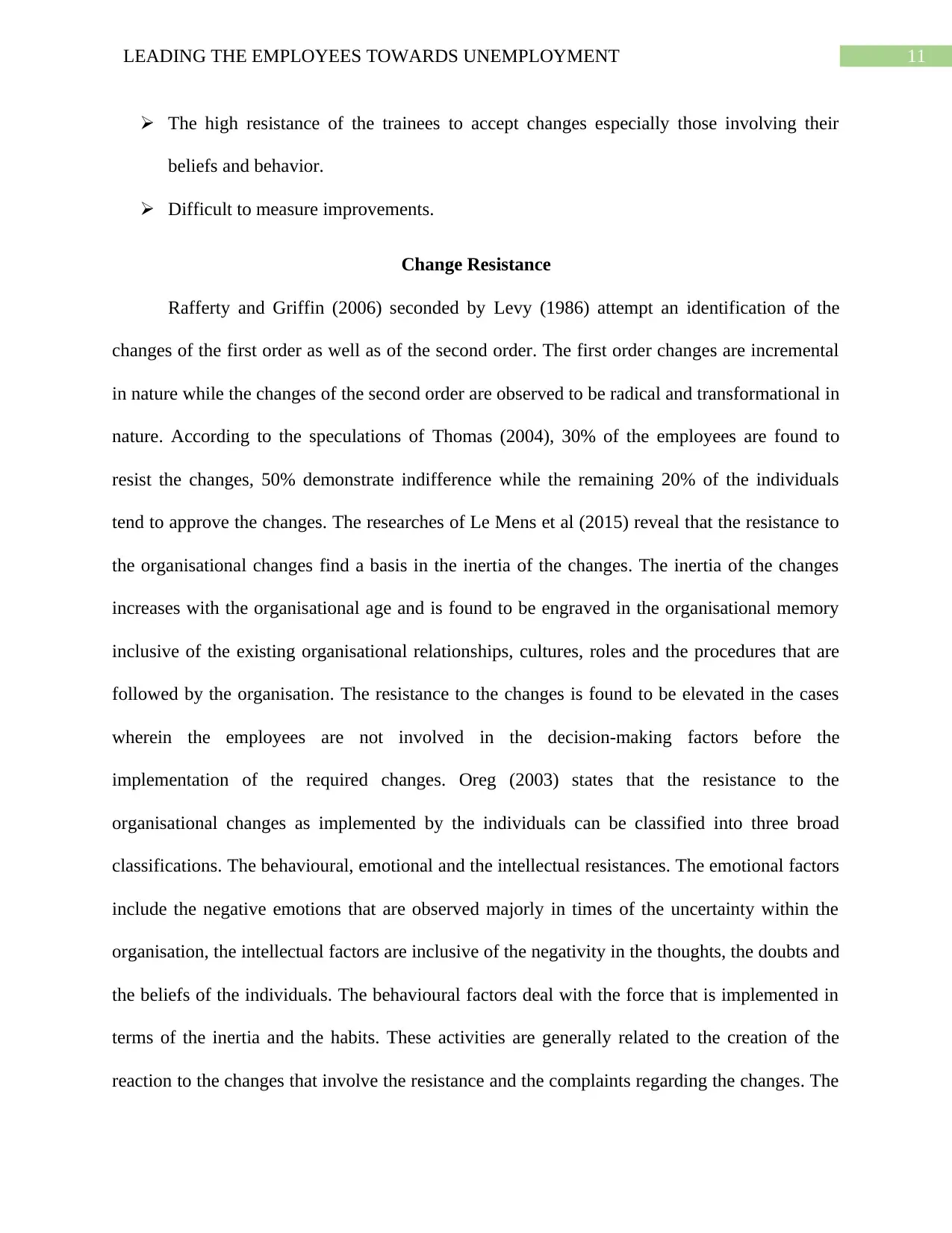
11LEADING THE EMPLOYEES TOWARDS UNEMPLOYMENT
The high resistance of the trainees to accept changes especially those involving their
beliefs and behavior.
Difficult to measure improvements.
Change Resistance
Rafferty and Griffin (2006) seconded by Levy (1986) attempt an identification of the
changes of the first order as well as of the second order. The first order changes are incremental
in nature while the changes of the second order are observed to be radical and transformational in
nature. According to the speculations of Thomas (2004), 30% of the employees are found to
resist the changes, 50% demonstrate indifference while the remaining 20% of the individuals
tend to approve the changes. The researches of Le Mens et al (2015) reveal that the resistance to
the organisational changes find a basis in the inertia of the changes. The inertia of the changes
increases with the organisational age and is found to be engraved in the organisational memory
inclusive of the existing organisational relationships, cultures, roles and the procedures that are
followed by the organisation. The resistance to the changes is found to be elevated in the cases
wherein the employees are not involved in the decision-making factors before the
implementation of the required changes. Oreg (2003) states that the resistance to the
organisational changes as implemented by the individuals can be classified into three broad
classifications. The behavioural, emotional and the intellectual resistances. The emotional factors
include the negative emotions that are observed majorly in times of the uncertainty within the
organisation, the intellectual factors are inclusive of the negativity in the thoughts, the doubts and
the beliefs of the individuals. The behavioural factors deal with the force that is implemented in
terms of the inertia and the habits. These activities are generally related to the creation of the
reaction to the changes that involve the resistance and the complaints regarding the changes. The
The high resistance of the trainees to accept changes especially those involving their
beliefs and behavior.
Difficult to measure improvements.
Change Resistance
Rafferty and Griffin (2006) seconded by Levy (1986) attempt an identification of the
changes of the first order as well as of the second order. The first order changes are incremental
in nature while the changes of the second order are observed to be radical and transformational in
nature. According to the speculations of Thomas (2004), 30% of the employees are found to
resist the changes, 50% demonstrate indifference while the remaining 20% of the individuals
tend to approve the changes. The researches of Le Mens et al (2015) reveal that the resistance to
the organisational changes find a basis in the inertia of the changes. The inertia of the changes
increases with the organisational age and is found to be engraved in the organisational memory
inclusive of the existing organisational relationships, cultures, roles and the procedures that are
followed by the organisation. The resistance to the changes is found to be elevated in the cases
wherein the employees are not involved in the decision-making factors before the
implementation of the required changes. Oreg (2003) states that the resistance to the
organisational changes as implemented by the individuals can be classified into three broad
classifications. The behavioural, emotional and the intellectual resistances. The emotional factors
include the negative emotions that are observed majorly in times of the uncertainty within the
organisation, the intellectual factors are inclusive of the negativity in the thoughts, the doubts and
the beliefs of the individuals. The behavioural factors deal with the force that is implemented in
terms of the inertia and the habits. These activities are generally related to the creation of the
reaction to the changes that involve the resistance and the complaints regarding the changes. The
⊘ This is a preview!⊘
Do you want full access?
Subscribe today to unlock all pages.

Trusted by 1+ million students worldwide
1 out of 20
Related Documents
Your All-in-One AI-Powered Toolkit for Academic Success.
+13062052269
info@desklib.com
Available 24*7 on WhatsApp / Email
![[object Object]](/_next/static/media/star-bottom.7253800d.svg)
Unlock your academic potential
Copyright © 2020–2025 A2Z Services. All Rights Reserved. Developed and managed by ZUCOL.





